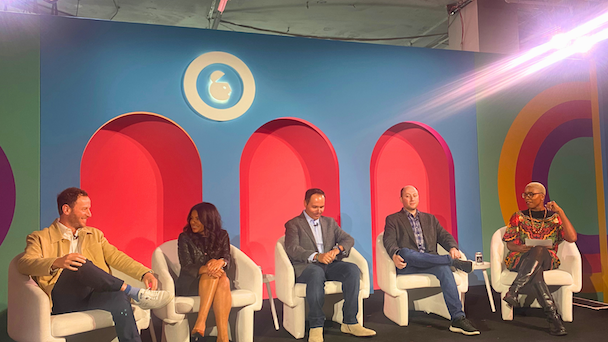Addressability, ad fraud, IDs, oh my: Experts debate all things media at Advertising Week
Key industry players from the buy side and the sell side are parsing the hottest issues in media today.

Experts explore the hottest issues in media today at Advertising Week New York 2023
In an increasingly fragmented media space, how can advertisers effectively reach audiences, reduce wasted ad spend, mitigate fraud and measure the impacts of their efforts?
These considerations are at the heart of conversations happening on the ground at Advertising Week New York 2023, where industry leaders have descended on midtown Manhattan to debate the industry’s hottest issues this week.
Advertisement
The need for cross-channel identity solutions
As the death of the cookie looms nearer, the industry is bracing for impact.
A key focus for many is adopting privacy-safe identity solutions that will allow advertisers to continue targeting and measuring media on an user level across channels.
“As you're testing solutions, you want to think about interoperability. The future is not going to be a one-ID future – we're going to have several, we’re going to have a patchwork of IDs,” said Shiv Gupta, founder and chief executive officer at adtech and martech education firm U of Digital. “Those IDs all need to play nice with each other and be able to translate to one another for a marketer to do what they need to do across different publishers, ecosystems and devices. So interoperability is key.”
Advertisers should cast a skeptical eye at ID providers whose solutions work only within specific ecosystems and don’t integrate seamlessly with other IDs, Gupta explained.
The importance of interoperability across IDs has been echoed widely among experts at Advertising Week New York this week. “At the end of the day,” said Samantha Jacobson, chief strategy officer at The Trade Desk, “we want to make sure we maximize addressability, and that we're making it as easy as possible for buyers. We recognize that there are going to be different ways to connect into different datasets, and we want to make sure we're not limiting datasets through the access of a particular identifier. Instead, we want to make it as easy as possible to execute and activate against them.”
As a publisher and adtech leader, Yahoo for its part has been focused on mastering interoperability from both the demand and supply sides. Though the company has offered interoperability with LiveRamp for years on the demand side, the company just this week announced a new effort to improve supply-side interoperability and scale its cookieless ID, Yahoo ConnectID, with LiveRamp.
“What we have offered to advertisers for many, many years, we are now able to offer to publishers as well, and simplify the way they can work with us through LiveRamp for a more interoperable ecosystem,” said Giovanni Gardelli, vice-president of ads data product at the company.
Advertisement
Convergence and fragmentation exert pressure on the media ecosystem
As the world of TV and premium video evolves, so too do viewing habits. Audiences are increasingly splitting their time across linear TV and streamed content – and last year, streaming surpassed cable networks in terms of total viewership for the first time, according to Nielsen data.
In many ways, experts agree, channels are converging, creating opportunities to develop more effective solutions for reaching target audiences in streamlined, simplified ways. Vizio Ads’ Nyma Quidwai, vice-president of client services and inventory partnerships, spoke about this idea at length during a fireside chat Monday. “Having a very strong adtech stack definitely helps to ensure that there's seamless ways to integrate into the inventory,” she concluded.
Nonetheless, fragmentation in the ecosystem persists, creating issues for cross-channel targeting and measurement.
As Sean Cunningham, chief executive at industry body the Video Advertising Bureau (VAB), put it Tuesday: “A lot of the issues [in media today] stem from the marketer desire to be able to have a one-level, single-source view of how their campaigns are running across their three major pieces of investment. They want to know, ‘What's my deduplicated reach and frequency among Google, Meta, Amazon and multi-screen TV?’ The problem is that right now, getting that done is [very difficult with] a mashup of mismatched data sources and data pieces.”
Groups like ratings and measurement firm Nielsen are leading the charge to develop cross-channel solutions and new currencies that will, in theory, enable advertisers to more easily assign value to all their media investments through one streamlined source. As it stands, however, progress on this front is still direly needed, experts say.
Suggested newsletters for you
An industry demanding greater transparency
A key theme among media conversations at Advertising Week New York this year has been demand for increased transparency within the digital media ecosystem – and, in particular, from the industry’s walled gardens, which still control the vast majority of ad spend globally.
The VAB for its part has made it a point to call out the issues that arise from poor transparency on the part of Google and Meta. Cunningham spoke onstage Tuesday about Google’s efforts to obscure parts of its ads ecosystem from media buyers, which has made it difficult for advertisers to understand the quality of their impressions and how much of their spend is wasted. “The reason that high standards and transparency are important is because the $110bn that we spend annually on the highest grade professional content is for [brands] to move goods and services,” said Cunningham. “You want to know the origin and the quality of the impressions.”
A lack of transparency within the buying ecosystem becomes especially problematic when it comes to combating ad fraud – an issue that costs the industry an estimated $35bn annually in North America alone, per data from verification firm Cheq.
“Is it possible to catch [fraud] after the fact? It's infinitely easier when there's transparency and placement reporting,” said Arielle Garcia consultant, advisor and fractional chief privacy officer at ASG Solutions and former chief privacy and responsibility officer at UM Worldwide. “It is up to advertisers to, up front, make their expectations for transparency known. And, if they decide to make a concession and use a product where placement reporting is not available, they should probably take extra measures to look for anomalies in the metrics in that campaign.”
Advertising industry players, it would seem, are more wary than ever about opacity within the media buying space.
Other key themes in media emerging at Advertising Week New York this year include the proliferation of retail media, AI’s role in the digital landscape and the collapse of the funnel.
For more, sign up for The Drum’s daily newsletter here.
